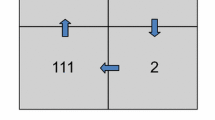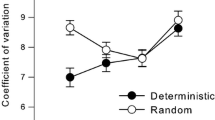Abstract
Patients with cerebellar damage are impaired on a range of timed tasks. However, recent research has indicated that the impairment on temporal production tasks is limited to discontinuous movements. The present experiments were designed to compare two accounts for the increased temporal variability observed in these patients when producing discontinuous movements. First, the impairment on discontinuous movements may be the result of the requirements associated with transitioning between movement onsets and offsets, requirements unique to discontinuous movement production. Second, the impairment may reflect a requirement to represent the temporal goal in timed, discontinuous movements. Patients with unilateral or bilateral cerebellar lesions and matched control subjects performed a key-pressing task. In one condition, the participants pressed and immediately released the key. The other conditions required the participants to press the key, and after either a 550-ms or 950-ms delay, release the key. Individuals with cerebellar damage were impaired on the two timed conditions. These results do not support the transition hypothesis. Rather, they are consistent with the hypothesis that the cerebellum is essential for tasks requiring precise event-like temporal control.







Similar content being viewed by others
Notes
We used all three movement types in the regression analyses. However, we have assumed that the press condition does not entail an explicit timed component: the duration of these movements reflects the minimum time that the key is pressed during the transition from press to lift. Given this, one could argue that the press condition does not contain a duration-dependent source of variability and the slope analysis should be restricted to just the short and long conditions. We also calculated slope and intercept values using just these two points. The statistical outcomes were unchanged in this more restricted analysis. However, we report the regression based on all three conditions since it does not require an assumption regarding whether or not the press movement type involves “timing.”
The effect size for the short and long conditions was used to estimate the power for identifying differences in the press condition given our group sizes. Power was low in experiment 1 (12% chance that we would detect significant difference between means in the press condition). This value increased to 62% in experiment 2.
References
Ackermann H, Graeber S, Hertrich I, Daum I (1997) Categorical speech perception in cerebellar disorders. Brain Lang 60:323–331
Billon M, Semjen A, Stelmach GE (1996) The timing effects of accent production in periodic finger-tapping sequences. J Mot Behav 28:198–210
Botez-Marquard T, Botez MI (1997) Olivopontocerebellar atrophy and Friedreich’s ataxia: neuropsychological consequences of bilateral versus unilateral cerebellar lesions. Int Rev Neurobiol 41:555–573
Conrad B, Brooks VB (1974) Effect of dentate cooling on rapid alternating arm movements. J Neurophysiol 37:792–804
Day BL, Thompson PD, Harding AE, Marsden CD (1998) Influence of vision on upper limb reaching movements in patients with cerebellar ataxia. Brain 121:357–372
Fiala JC, Grossberg S, Bullock D (1996) Metabotropic glutamate receptor activation in cerebellar Purkinje cells as substrate for adaptive timing of the classically conditioned eye-blink response. J Neurosci 16:3760–3774
Franz EA, Ivry RB, Helmuth LL (1996) Reduced timing variability in patients with unilateral cerebellar lesions during bimanual movements. J Cogn Neurosci 8:107–118
Freund H-J (1983) Motor unit and muscle activity in voluntary motor control. Physiol Rev 63:387–436
Getty D (1975) Discrimination of short temporal intervals: a comparison of two models. Percept Psychophys 18:1–8
Gerwig M, Dimitrova A, Kolb FP, Maschke M, Brol B, Kunnel A, Boring D, Thilmann AF, Forsting M, Diener HC, Timmann D (2003) Comparison of eyeblink conditioning in patients with superior and posterior inferior cerebellar lesions. Brain 126:71–94
Gibbon J (1977) Scalar expectancy theory and Weber’s law in animal timing. Psychol Rev 84:279–325
Hallet M, Shahani BT, Young RR (1975) EMG analysis of patients with cerebellar deficits. J Neurol Neurosurg Psychiatry 38:1163–1169
Harrington DL, Haaland KY, Hermanowitz N (1998) Temporal processing in the basal ganglia. Neuropsychology 12:3–12
Harrington DL, Lee RR, Boyd LA, Rapcsak SZ, Knight RT (2004) Does the representation of time depend on the cerebellum? Effect of cerebellar stroke. Brain 127:1–14
Hogan N, Flash T (1987) Moving gracefully: quantitative theories of motor coordination. Trends Neurosci 10:170–174
Hore J, Watts S, Tweed D, Miller B (1996) Overarm throws with the nondominant arm: kinematics of accuracy. J Neurophysiol 76:3693–3704
Hore J, Wild B, Diener H (1991) Cerebellar dysmetria at the elbow, wrist, and fingers. J Neurophysiol 62:563–571
Ivry RB, Corcos DM (1993) Slicing the variability pie: component analysis of coordination and motor dysfunction. In: Newell KM, Corcos DM (eds) Variability and motor control. Human Kinetics, Urbana, IL, pp 415–447
Ivry RB, Hazeltine RE (1995) Perception and production of temporal intervals across a range of durations: evidence for a common timing mechanism. J Exp Psychol Hum Percept Perform 21:3–18
Ivry RB, Keele SW (1989) Timing functions of the cerebellum. J Cogn Neurosci 1:136–152
Ivry RB, Keele SW, Diener HC (1988) Dissociation of the lateral and medial cerebellum in movement timing and movement execution. Exp Brain Res 73:167–180
Ivry RB, Spencer RM, Zelaznik HN, Diedrichsen J (2002) The cerebellum and event timing. Ann N Y Acad Sci 978:302–317
Kahneman D (1973) Attention and effort. Prentice Hall, Engle Cliffs, NJ
Keele SW, Pokorny RA, Corcos DM, Ivry RB (1985) Do perception and motor production share common timing mechanisms: a correlational analysis. Acta Psychol (Amst) 60:173–191
Mangels JA, Ivry RB, Shimizu N (1998) Dissociable contributions of the frontal and neocerebellar cortex to time perception. Cogn Brain Res 7:15–39
Medina JF, Mauk MD (2000) Computer simulation of cerebellar information processing. Nat Neurosci 3:1205–1211
Meyer-Lohmann J, Hore J, Brooks VB (1977) Cerebellar participation in generation of prompt arm movements. J Neurophysiol 40:1038–1050
Nichelli P, Alway D, Grafman J (1996) Perceptual timing in cerebellar degeneration. Neuropsychologia 34:863–871
Ravizza S, Ivry RB (2001) Comparison of the basal ganglia and cerebellum in shifting attention. J Cogn Neurosci 13:284–297
Robertson SD, Zelaznik HN, Lantero DA, Bojczyk KG, Spencer RM, Doffin JG, Schneidt T (1999) Correlations for timing consistency among tapping and drawing tasks: evidence against a single timing process for motor control. J Exp Psychol Hum Percept Perform 25:1316–1330
Spencer RMC, Ivry RB (2004) Comparison of patients with Parkinson’s disease or cerebellar lesions in the production of periodic movements involving event-based or emergent timing. Brain Cogn, in press
Spencer RMC, Zelaznik HN, Diedrichsen J, Ivry RB (2003) Disrupted timing of discontinuous but not continuous movements by cerebellar lesions. Science 300:1437–1439
Spidalieri G, Busby L, Lamarre Y (1983) Fast ballistic arm movements triggered by visual, auditory, and somesthetic stimuli in monkey. II. Effects of unilateral dentate lesion on discharge of precentral cortical neurons and reaction time. J Neurophysiol 50:1359–1379
Timmann D, Watts S, Hore J (2000) Causes of left-right ball inaccuracy in overarm throws made by cerebellar patients. Exp Brain Res 130:441–452
Trouillas P, Takayanagi T, Hallett M, et al. (1997) International Cooperative Ataxia Rating Scale for pharmacological assessment of the cerebellar syndrome. J Neurol Sci 145:205–211
van Beers RJ, Baraduc P, Wolpert DM (2002) Role of uncertainty in sensorimotor control. Philos Trans R Soc Lond B Biol Sci 357:1137–1145
Woodruff-Pak, DS, Papka M, Ivry RB (1996) Cerebellar involvement in eyeblink classical conditioning in humans. Neuropsychology 10:443–458
Zelaznik HN, Spencer RM, Doffin J (2000) Temporal precision in tapping and circle drawing movements at preferred rates is not correlated: further evidence against timing as a general purpose ability. J Mot Behav 32:193–199
Zelaznik HN, Spencer RM, Ivry RB (2002) Dissociation of explicit and implicit timing processes in repetitive tapping and drawing movements. J Exp Psychol Hum Percept Perform 28:575–588
Acknowledgements
This research was support by grants NIH P01 and NS40813.
Author information
Authors and Affiliations
Corresponding author
Rights and permissions
About this article
Cite this article
Spencer, R.M.C., Ivry, R.B. & Zelaznik, H.N. Role of the cerebellum in movements: control of timing or movement transitions?. Exp Brain Res 161, 383–396 (2005). https://doi.org/10.1007/s00221-004-2088-6
Received:
Accepted:
Published:
Issue Date:
DOI: https://doi.org/10.1007/s00221-004-2088-6




